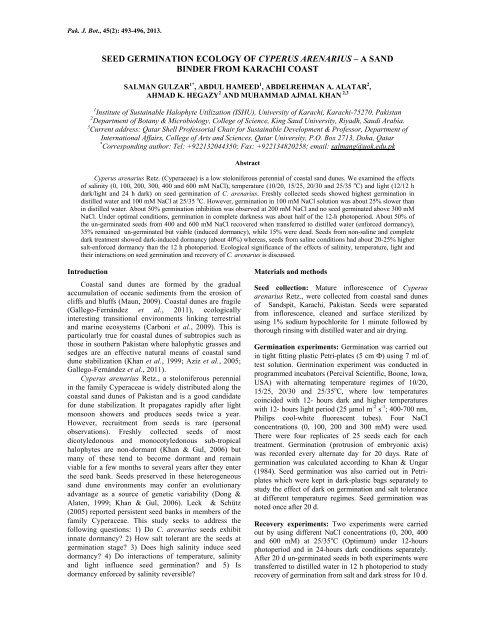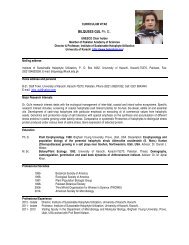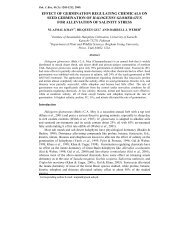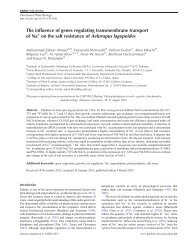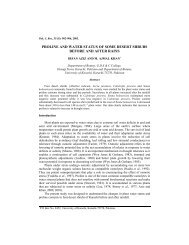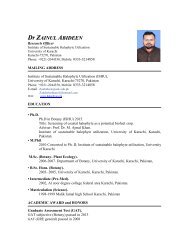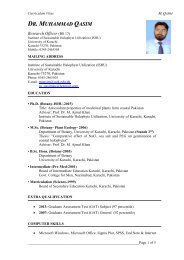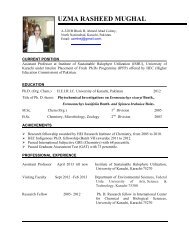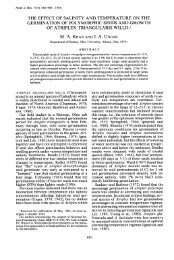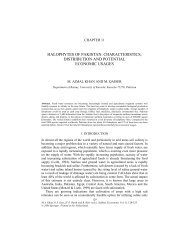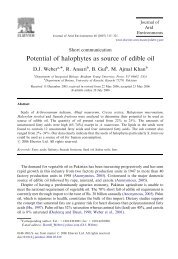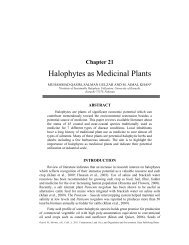seed germination ecology of cyperus arenarius â a ... - ResearchGate
seed germination ecology of cyperus arenarius â a ... - ResearchGate
seed germination ecology of cyperus arenarius â a ... - ResearchGate
You also want an ePaper? Increase the reach of your titles
YUMPU automatically turns print PDFs into web optimized ePapers that Google loves.
Pak. J. Bot., 45(2): 493-496, 2013.<br />
SEED GERMINATION ECOLOGY OF CYPERUS ARENARIUS – A SAND<br />
BINDER FROM KARACHI COAST<br />
SALMAN GULZAR 1* , ABDUL HAMEED 1 , ABDELREHMAN A. ALATAR 2 ,<br />
AHMAD K. HEGAZY 2 AND MUHAMMAD AJMAL KHAN 2,3<br />
1 Institute <strong>of</strong> Sustainable Halophyte Utilization (ISHU), University <strong>of</strong> Karachi, Karachi-75270, Pakistan<br />
2 Department <strong>of</strong> Botany & Microbiology, College <strong>of</strong> Science, King Saud University, Riyadh, Saudi Arabia.<br />
3 Current address: Qatar Shell Pr<strong>of</strong>essorial Chair for Sustainable Development & Pr<strong>of</strong>essor, Department <strong>of</strong><br />
International Affairs, College <strong>of</strong> Arts and Sciences, Qatar University, P.O. Box 2713, Doha, Qatar<br />
* Corresponding author: Tel: +922132044350; Fax: +922134820258; email: salmang@uok.edu.pk<br />
Abstract<br />
Cyperus <strong>arenarius</strong> Retz. (Cyperaceae) is a low stoloniferous perennial <strong>of</strong> coastal sand dunes. We examined the effects<br />
<strong>of</strong> salinity (0, 100, 200, 300, 400 and 600 mM NaCl), temperature (10/20, 15/25, 20/30 and 25/35 o C) and light (12/12 h<br />
dark/light and 24 h dark) on <strong>seed</strong> <strong>germination</strong> <strong>of</strong> C. <strong>arenarius</strong>. Freshly collected <strong>seed</strong>s showed highest <strong>germination</strong> in<br />
distilled water and 100 mM NaCl at 25/35 o C. However, <strong>germination</strong> in 100 mM NaCl solution was about 25% slower than<br />
in distilled water. About 50% <strong>germination</strong> inhibition was observed at 200 mM NaCl and no <strong>seed</strong> germinated above 300 mM<br />
NaCl. Under optimal conditions, <strong>germination</strong> in complete darkness was about half <strong>of</strong> the 12-h photoperiod. About 50% <strong>of</strong><br />
the un-germinated <strong>seed</strong>s from 400 and 600 mM NaCl recovered when transferred to distilled water (enforced dormancy),<br />
35% remained un-germinated but viable (induced dormancy), while 15% were dead. Seeds from non-saline and complete<br />
dark treatment showed dark-induced dormancy (about 40%) whereas, <strong>seed</strong>s from saline conditions had about 20-25% higher<br />
salt-enforced dormancy than the 12 h photoperiod. Ecological significance <strong>of</strong> the effects <strong>of</strong> salinity, temperature, light and<br />
their interactions on <strong>seed</strong> <strong>germination</strong> and recovery <strong>of</strong> C. <strong>arenarius</strong> is discussed.<br />
Introduction<br />
Coastal sand dunes are formed by the gradual<br />
accumulation <strong>of</strong> oceanic sediments from the erosion <strong>of</strong><br />
cliffs and bluffs (Maun, 2009). Coastal dunes are fragile<br />
(Gallego-Fernández et al., 2011), ecologically<br />
interesting transitional environments linking terrestrial<br />
and marine ecosystems (Carboni et al., 2009). This is<br />
particularly true for coastal dunes <strong>of</strong> subtropics such as<br />
those in southern Pakistan where halophytic grasses and<br />
sedges are an effective natural means <strong>of</strong> coastal sand<br />
dune stabilization (Khan et al., 1999; Aziz et al., 2005;<br />
Gallego-Fernández et al., 2011).<br />
Cyperus <strong>arenarius</strong> Retz., a stoloniferous perennial<br />
in the family Cyperaceae is widely distributed along the<br />
coastal sand dunes <strong>of</strong> Pakistan and is a good candidate<br />
for dune stabilization. It propagates rapidly after light<br />
monsoon showers and produces <strong>seed</strong>s twice a year.<br />
However, recruitment from <strong>seed</strong>s is rare (personal<br />
observations). Freshly collected <strong>seed</strong>s <strong>of</strong> most<br />
dicotyledonous and monocotyledonous sub-tropical<br />
halophytes are non-dormant (Khan & Gul, 2006) but<br />
many <strong>of</strong> these tend to become dormant and remain<br />
viable for a few months to several years after they enter<br />
the <strong>seed</strong> bank. Seeds preserved in these heterogeneous<br />
sand dune environments may confer an evolutionary<br />
advantage as a source <strong>of</strong> genetic variability (Dong &<br />
Alaten, 1999; Khan & Gul, 2006). Leck & Schütz<br />
(2005) reported persistent <strong>seed</strong> banks in members <strong>of</strong> the<br />
family Cyperaceae. This study seeks to address the<br />
following questions: 1) Do C. <strong>arenarius</strong> <strong>seed</strong>s exhibit<br />
innate dormancy? 2) How salt tolerant are the <strong>seed</strong>s at<br />
<strong>germination</strong> stage? 3) Does high salinity induce <strong>seed</strong><br />
dormancy? 4) Do interactions <strong>of</strong> temperature, salinity<br />
and light influence <strong>seed</strong> <strong>germination</strong>? and 5) Is<br />
dormancy enforced by salinity reversible?<br />
Materials and methods<br />
Seed collection: Mature inflorescence <strong>of</strong> Cyperus<br />
<strong>arenarius</strong> Retz., were collected from coastal sand dunes<br />
<strong>of</strong> Sandspit, Karachi, Pakistan. Seeds were separated<br />
from inflorescence, cleaned and surface sterilized by<br />
using 1% sodium hypochlorite for 1 minute followed by<br />
thorough rinsing with distilled water and air drying.<br />
Germination experiments: Germination was carried out<br />
in tight fitting plastic Petri-plates (5 cm Ф) using 7 ml <strong>of</strong><br />
test solution. Germination experiment was conducted in<br />
programmed incubators (Percival Scientific, Boone, Iowa,<br />
USA) with alternating temperature regimes <strong>of</strong> 10/20,<br />
15/25, 20/30 and 25/35 o C, where low temperatures<br />
coincided with 12- hours dark and higher temperatures<br />
with 12- hours light period (25 μmol m -2 s -1 ; 400-700 nm,<br />
Philips cool-white fluorescent tubes). Four NaCl<br />
concentrations (0, 100, 200 and 300 mM) were used.<br />
There were four replicates <strong>of</strong> 25 <strong>seed</strong>s each for each<br />
treatment. Germination (protrusion <strong>of</strong> embryonic axis)<br />
was recorded every alternate day for 20 days. Rate <strong>of</strong><br />
<strong>germination</strong> was calculated according to Khan & Ungar<br />
(1984). Seed <strong>germination</strong> was also carried out in Petriplates<br />
which were kept in dark-plastic bags separately to<br />
study the effect <strong>of</strong> dark on <strong>germination</strong> and salt tolerance<br />
at different temperature regimes. Seed <strong>germination</strong> was<br />
noted once after 20 d.<br />
Recovery experiments: Two experiments were carried<br />
out by using different NaCl concentrations (0, 200, 400<br />
and 600 mM) at 25/35 o C (Optimum) under 12-hours<br />
photoperiod and in 24-hours dark conditions separately.<br />
After 20 d un-germinated <strong>seed</strong>s in both experiments were<br />
transferred to distilled water in 12 h photoperiod to study<br />
recovery <strong>of</strong> <strong>germination</strong> from salt and dark stress for 10 d.
494<br />
SALMAN GULZAR ET AL.,<br />
Statistical analyses: Three-way analysis <strong>of</strong> variance<br />
(ANOVA) was conducted to determine if the<br />
experimental factors affect <strong>seed</strong> <strong>germination</strong> significantly.<br />
Post-hoc testing <strong>of</strong> ANOVA was conducted by using<br />
Bonferroni test (p
SEED GERMINATION ECOLOGY OF CYPERUS ARENARIUS A SAND BINDER FROM KARACHI COAST 495<br />
et al., 2011). Increases in salt concentration also inhibited<br />
<strong>germination</strong> in Cyperus capitatus <strong>seed</strong>s and no<br />
<strong>germination</strong> observed above 1% NaCl (Redondo-Gómez<br />
et al., 2011). Halopyrum mucronatum, a coastal dune<br />
species in the family Poaceae is little affected by 100 mM<br />
NaCl at <strong>germination</strong> stage compared to non-saline control<br />
at 25/35 o C. However, subsequent increases in salinity<br />
substantially inhibited its <strong>seed</strong> <strong>germination</strong> by 25% and<br />
10% NaCl, at 200 mM and 300 mM NaCl, respectively.<br />
Rate <strong>of</strong> Germination<br />
40 0 mM<br />
100 mM<br />
200 mM<br />
300 mM<br />
30<br />
20<br />
10<br />
0<br />
10-20 15-25 20-30 25-35<br />
Temperature ( o C)<br />
Fig. 2. Rate <strong>of</strong> <strong>germination</strong> <strong>of</strong> Cyperus <strong>arenarius</strong> in response to<br />
salinity (0, 100, 200 and 300 mM NaCl) and temperature (10-20,<br />
15-25, 20-30 and 25-35 o C) regimes.<br />
Increases in salinity results in a progressive decrease<br />
in <strong>seed</strong> <strong>germination</strong> <strong>of</strong> most halophytes but the<br />
detrimental effects are less severe at optimum temperature<br />
(Khan et al., 2000; Khan & Gulzar, 2003; Al-Khateeb,<br />
2006; Khan & Gul, 2006). Desmostachia bipinnata <strong>seed</strong>s<br />
appeared to germinate better at 25/35 o C than at lower<br />
temperature regimes (Gulzar et al., 2007), that is similar<br />
to our test species, while most co-occurring species<br />
preferred moderate temperature regime <strong>of</strong> 20/30 o C (Khan<br />
& Gulzar, 2003; Khan & Gul, 2006). Germination<br />
preference for higher temperatures in the dune<br />
environment could be due to niche separation to avoid<br />
competition with other species along the coast which<br />
occupied more stable soils with finer texture.<br />
Light requirement <strong>of</strong> halophytes is quite variable<br />
among species (Baskin & Baskin 1998). It prevents<br />
<strong>germination</strong> when <strong>seed</strong>s are either buried in soil or shaded<br />
by dense vegetation or litter (Schütz & Rave, 1999;<br />
Hroudova´ & Zakravski, 2003). Baskin and Baskin (1998)<br />
reviewed that <strong>seed</strong> <strong>germination</strong> in members <strong>of</strong><br />
Cyperaceae was higher in light than in dark, with 18 <strong>of</strong> 43<br />
species germinating only in light. In this study, dark<br />
substantially inhibited the <strong>seed</strong> <strong>germination</strong> in comparison<br />
to 12 h photoperiod, irrespective <strong>of</strong> salinity and<br />
temperature treatments. This dark-induced <strong>germination</strong><br />
inhibition appears a strategy to avoid <strong>germination</strong> in deep<br />
layers <strong>of</strong> the soil due to burial, which could be fatal for<br />
emerging <strong>seed</strong>lings.<br />
Germinated<br />
Recovered<br />
Live<br />
Dead<br />
Germinated<br />
Recovered<br />
Live<br />
Dead<br />
100<br />
100<br />
Percentage<br />
Percentage<br />
80<br />
60<br />
40<br />
Percentage<br />
80<br />
60<br />
40<br />
20<br />
20<br />
0<br />
0 200 400 600<br />
NaCl (mM)<br />
0<br />
0 200 400 600<br />
NaCl (mM)<br />
Fig. 3. Percentage <strong>of</strong> germinated, recovered, alive and dead <strong>seed</strong>s <strong>of</strong><br />
Cyperus <strong>arenarius</strong> in response to salinity (0, 200 400 and 600 mM<br />
NaCl) at 25/35 o C temperature regime in 12-h photoperiod.<br />
Recovery <strong>of</strong> <strong>seed</strong> <strong>germination</strong> upon alleviation <strong>of</strong> salt<br />
stress is reported for a number <strong>of</strong> halophyte species (Shen<br />
et al., 2003; Khan & Gul, 2006). The recovery responses<br />
<strong>of</strong> monocotyledonous species from saline conditions<br />
appear to be as variable as their <strong>germination</strong> responses.<br />
Fig. 4. Percentage <strong>of</strong> germinated, recovered, alive and dead <strong>seed</strong>s <strong>of</strong><br />
Cyperus <strong>arenarius</strong>, in response to salinity (0, 200 400 and 600 mM<br />
NaCl) at 25/35 o C temperature regime in complete dark.<br />
For instance, Aeluropus lagopoides (Gulzar & Khan,<br />
2001) and Urochondra setulosa (Gulzar et al., 2001)<br />
showed a high (85%) recovery at 600 mM NaCl at their<br />
optimum temperature regime, whereas Sporobolus<br />
ioclados (Khan & Gulzar, 2003) recovered poorly due to
496<br />
SALMAN GULZAR ET AL.,<br />
innate dormancy. Germination responses <strong>of</strong> C. <strong>arenarius</strong><br />
appear to fall between the above two categories. About<br />
50% recovery after removal <strong>of</strong> salt stress under optimum<br />
temperature and photoperiod regimes indicates enforced<br />
<strong>seed</strong> dormancy in C. <strong>arenarius</strong>, due to osmotic stress.<br />
Whereas, about 35% <strong>of</strong> the un-germinated <strong>seed</strong>s from<br />
high salt treatments were viable (induced dormancy) and<br />
15% were dead. Complete darkness and non-saline<br />
conditions caused induced dormancy in about 40% <strong>seed</strong>s<br />
which did not germinate after transfer to 12/12h<br />
photoperiod regime. Un-germinated <strong>seed</strong>s from highly<br />
saline conditions (400 and 600 mM NaCl) and complete<br />
darkness showed 20-25% more enforced dormancy and a<br />
similar reduction in induced dormancy in comparison<br />
with <strong>seed</strong>s from the 12 h photoperiod regime.<br />
Conclusion<br />
Cyperus <strong>arenarius</strong> is sensitive to saline conditions,<br />
particularly in the absence <strong>of</strong> light. However, it can<br />
tolerate high temperatures and can recover from up to<br />
seawater salinity under optimal temperature and light<br />
regimes. Seed <strong>germination</strong> appears to be tightly regulated<br />
by interactive effects <strong>of</strong> the major environmental factors.<br />
Similar responses <strong>of</strong> other sand dune species in the genus<br />
Cyperus (Thullen & Keeley, 1979; El Keblawy et al.,<br />
2011) as well as other monocotyledonous halophytes <strong>of</strong><br />
coastal sand dunes can be considered as indicators <strong>of</strong> a<br />
common adaptive response for long term survival in<br />
stressful conditions.<br />
Acknowledgement<br />
The authors extend their appreciation to the deanship<br />
<strong>of</strong> scientific research at King Saud University for funding<br />
the work through the research group project No. RGP-<br />
VPP-175.<br />
References<br />
Al-Khateeb, S.A. 2006. Effect <strong>of</strong> salinity and temperature on<br />
<strong>germination</strong>, growth and ion relations <strong>of</strong> Panicum turgidum<br />
Forssk. Bioresource Technol., 97: 292-298.<br />
Anwar, S., M. Shafi, J. Bakht, M.T. Jan and Y. Hayat. 2011.<br />
Response <strong>of</strong> barley genotypes to salinity stress as alleviated<br />
by <strong>seed</strong> priming. Pak. J. Bot., 43: 2687-2691.<br />
Arshad, M., M. Saqib, J. Akhtar and M. Asghar. 2012. Effect <strong>of</strong><br />
calcium on the salt tolerance <strong>of</strong> different wheat (Triticum<br />
aestivum L.) genotypes. Pak. J. Agri. Sci., 49: 497-504.<br />
Aziz, I., S. Gulzar, Noor, M., and M. A. Khan. 2005. Water<br />
relations <strong>of</strong> a coastal dune grass Halopyrum mucronatum<br />
(L.) Stapf. Pak. J. Bot., 37: 141-148.<br />
Balestri, E. and F. Cinelli. 2004. Germination and Early-<br />
Seedling Establishment Capacity <strong>of</strong> Pancratium maritimum<br />
L. (Amaryllidaceae) on Coastal Dunes in the North-<br />
Western Mediterranean. J. Coastal Res., 20: 761-770.<br />
Baskin, C.C. and J.M. Baskin. 1998. Seeds: Ecology,<br />
biogeography, and evolution <strong>of</strong> dormancy and <strong>germination</strong>.<br />
San Diego, Academic Press.<br />
Carboni, M., M.L. Carranza and A. Acosta. 2009. Assessing<br />
conservation status on coastal dunes: A multiscale<br />
approach. Landscape Urban Plan., 91: 17-25.<br />
Dong, M. and B. Alaten. 1999. Clonal plasticity in response to<br />
rhizome severing and heterogeneous resource supply in the<br />
rhizomatous grass Psammochloa villosa in an Inner<br />
Mongolian dune, China. Plant Ecol., 141: 53-58.<br />
(Received for publication 16 August 2011)<br />
El Keblawy, A., S.S. Al Neyadi, M.V.Rao and A. Al-Marzouqi.<br />
2011. Interactive effects <strong>of</strong> salinity, light and temperature<br />
on <strong>seed</strong> <strong>germination</strong> <strong>of</strong> sand dunes glycophyte Cyprus<br />
conglomeratus growing in the United Arab Emirates<br />
deserts. Seed Sci. & Technol., 39: 364-376.<br />
Gallego-Fernández, J.B., I.A. Sánchez and C. Ley. 2011.<br />
Restoration <strong>of</strong> isolated and small coastal sand dunes on the<br />
rocky coast <strong>of</strong> northern Spain. Ecol. Eng., 37: 1822-1832.<br />
Gul, B., R. Ansari, I. Aziz and M.A. Khan. 2010. Salt tolerance<br />
<strong>of</strong> Kochia scoparia: a new fodder crop for highly saline<br />
regions. Pak. J. Bot., 42: 2479-2487.<br />
Gulzar, S. and M.A. Khan. 2001. Seed <strong>germination</strong> <strong>of</strong> a<br />
halophytic grass Aeluropus lagopoides. Ann. Bot.-London,<br />
87: 319-324.<br />
Gulzar, S., M.A. Khan and I.A. Ungar. 2001. Effect <strong>of</strong><br />
temperature and salinity on the <strong>germination</strong> <strong>of</strong> Urochondra<br />
setulosa. Seed Sci. & Technol., 29: 21-29.<br />
Gulzar, S., M.A. Khan and X. Liu. 2007. Seed <strong>germination</strong><br />
strategies <strong>of</strong> Desmostachya bipinnata: a fodder crop for<br />
saline soils. Rangeland Ecol. Manag., 60: 401-407.<br />
Hroudová, Z. and P. Zákravský. 2003. Germination responses <strong>of</strong><br />
diploid Butomus umbellatus to light, temperature and<br />
flooding. Flora, 198: 37-44.<br />
Khan, M.A and B. Gul. 2002. Some ecophysiological aspects <strong>of</strong><br />
<strong>seed</strong> <strong>germination</strong> in halophytes. In: X. Liu, and M. Liu.<br />
(Eds.) Halophyte Utilization and Regional Sustainable<br />
Development <strong>of</strong> Agriculture, pp. 56-68. Metereological<br />
Press, Beijing, China.<br />
Khan, M.A. and B. Gul. 2006. Halophyte <strong>seed</strong> <strong>germination</strong>. In M.<br />
A. Khan, and D. J. Weber(Eds.). Eco-physiology <strong>of</strong> High<br />
Salinity Tolerant Plants. pp. 11-30. Springer, Netherlands.<br />
Khan, M.A. and I.A. Ungar. 1984. Effects <strong>of</strong> salinity and<br />
temperature on the <strong>germination</strong> and growth <strong>of</strong> Atriplex<br />
triangularis Willd. Am. J. Bot., 71: 481-489.<br />
Khan, M.A. and S. Gulzar. 2003. Light, salinity and temperature<br />
effects on the <strong>seed</strong> <strong>germination</strong> <strong>of</strong> perennial grasses. Am. J.<br />
Bot., 90: 131-134.<br />
Khan, M.A., B. Gul, and D.J. Weber. 2000. Germination<br />
responses to Salicornia rubra to temperature and salinity. J.<br />
Arid Environ., 45: 207-214.<br />
Khan, M.A., I.A. Ungar and A.M. Showalter. 1999. The effect <strong>of</strong><br />
salinity on growth, ion content, and osmotic relations in<br />
Halopyrum mucronatum (L.) Stapf. J. Plant Nutr., 22: 191-204.<br />
Leck, M.A. and W. Schütz .2005. Regeneration <strong>of</strong> Cyperaceae,<br />
with particular reference to <strong>seed</strong> <strong>ecology</strong> and <strong>seed</strong> banks.<br />
Perspect. Plant Ecol., 7: 95-133.<br />
Maun, M.A. 2009. The Biology <strong>of</strong> Coastal Sand Dunes. Oxford<br />
University Press.<br />
Redondo-Gómez, S., L. Andrades-Moreno, R. Parra, E. Mateos-<br />
Naranjo, A.M. Sánchez-Lafuente. 2011. Factors<br />
influencing <strong>seed</strong> <strong>germination</strong> <strong>of</strong> Cyperus capitatus,<br />
inhabiting the moving sand dunes in southern Europe. J.<br />
Arid Environ., 75: 309-312.<br />
Saeed, S., B. Gul and M.A.Khan. 2011. Comparative effects <strong>of</strong><br />
NaCl and sea salt on <strong>seed</strong> <strong>germination</strong> <strong>of</strong> Arthrocnemum<br />
indicum. Pak. J. Bot., 43: 2-14.<br />
Schütz, W. and G. Rave. 1999. The effect <strong>of</strong> cold stratification<br />
and light on the <strong>seed</strong> <strong>germination</strong> <strong>of</strong> temperate sedges<br />
(Carex) from various habitats and implications for<br />
regenerative strategies. Plant Ecol., 144: 215-230.<br />
Shen, Y.Y., Y. Li and S.G. Yan. 2003. Effects <strong>of</strong> salinity on<br />
<strong>germination</strong> <strong>of</strong> six salt tolerant forage species and their recovery<br />
from saline conditions, New Zeal. J. Agr. Res., 46: 263-269.<br />
Thullen, R.J. and P.E. Keeley. 1979. Seed Production and<br />
Germination in Cyperus esculentus and C. rotundus. Weed<br />
Sci., 27: 502-505.


